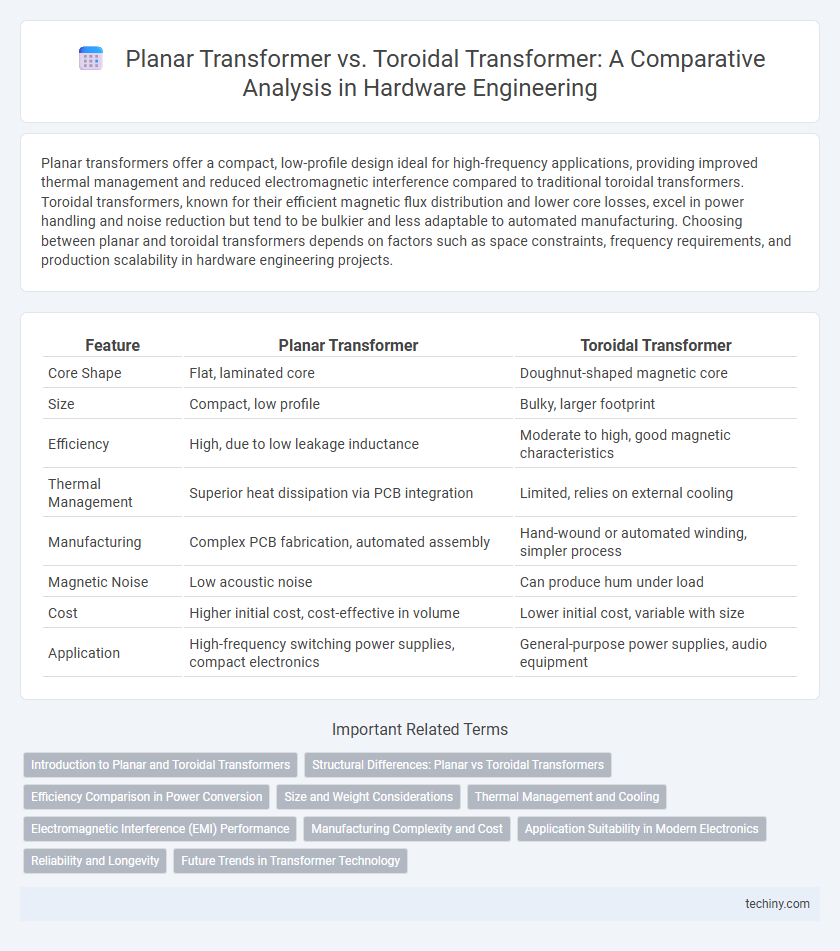Planar transformers offer a compact, low-profile design ideal for high-frequency applications, providing improved thermal management and reduced electromagnetic interference compared to traditional toroidal transformers. Toroidal transformers, known for their efficient magnetic flux distribution and lower core losses, excel in power handling and noise reduction but tend to be bulkier and less adaptable to automated manufacturing. Choosing between planar and toroidal transformers depends on factors such as space constraints, frequency requirements, and production scalability in hardware engineering projects.
Table of Comparison
| Feature | Planar Transformer | Toroidal Transformer |
|---|---|---|
| Core Shape | Flat, laminated core | Doughnut-shaped magnetic core |
| Size | Compact, low profile | Bulky, larger footprint |
| Efficiency | High, due to low leakage inductance | Moderate to high, good magnetic characteristics |
| Thermal Management | Superior heat dissipation via PCB integration | Limited, relies on external cooling |
| Manufacturing | Complex PCB fabrication, automated assembly | Hand-wound or automated winding, simpler process |
| Magnetic Noise | Low acoustic noise | Can produce hum under load |
| Cost | Higher initial cost, cost-effective in volume | Lower initial cost, variable with size |
| Application | High-frequency switching power supplies, compact electronics | General-purpose power supplies, audio equipment |
Introduction to Planar and Toroidal Transformers
Planar transformers utilize flat, printed circuit board (PCB) windings that enable a compact design and improved thermal management, making them ideal for high-frequency applications. Toroidal transformers feature a doughnut-shaped core with wire windings, offering low electromagnetic interference (EMI) and high efficiency, commonly used in power supply units. Both transformer types serve crucial roles in hardware engineering, with planar transformers excelling in space-constrained, high-frequency environments, and toroidal transformers preferred for low-noise, high-efficiency power conversion.
Structural Differences: Planar vs Toroidal Transformers
Planar transformers feature a flat, layered winding structure utilizing printed circuit boards (PCBs), resulting in a compact and low-profile design ideal for high-frequency applications. Toroidal transformers consist of wire windings wrapped around a ring-shaped magnetic core, offering superior magnetic flux distribution and reduced electromagnetic interference (EMI). The planar design enhances thermal management and manufacturing repeatability, while toroidal transformers deliver higher efficiency in power handling and lower audible noise.
Efficiency Comparison in Power Conversion
Planar transformers exhibit higher efficiency in power conversion due to reduced winding resistance and shorter magnetic paths compared to toroidal transformers. The compact design of planar transformers minimizes parasitic inductance and losses, resulting in improved thermal performance and energy savings. Torque and magnetic flux density in toroidal transformers often lead to slightly increased core and copper losses, impacting overall efficiency in high-frequency applications.
Size and Weight Considerations
Planar transformers offer a more compact and lightweight design compared to traditional toroidal transformers, making them ideal for applications with strict space constraints. Their flat, layered construction reduces the overall volume and allows for better heat dissipation, contributing to improved performance in high-frequency circuits. Toroidal transformers, while efficient, typically have a bulkier form factor and heavier mass due to their wound core, limiting their use in miniaturized hardware engineering projects.
Thermal Management and Cooling
Planar transformers offer superior thermal management due to their low profile and large surface area, enabling efficient heat dissipation through direct contact with heat sinks and printed circuit boards. Toroidal transformers, while compact and efficient in magnetic performance, often experience localized hotspots because their enclosed winding design limits airflow and cooling options. Effective cooling in planar transformers reduces thermal resistance, enhancing reliability and allowing higher power density compared to toroidal counterparts.
Electromagnetic Interference (EMI) Performance
Planar transformers exhibit superior electromagnetic interference (EMI) performance compared to toroidal transformers due to their low profile and controlled winding geometry, which reduces parasitic capacitance and leakage inductance. The optimized layout in planar transformers minimizes radiated and conducted EMI emissions, making them ideal for high-frequency applications in compact hardware designs. Toroidal transformers, while efficient in magnetic flux confinement, often produce higher EMI levels due to less precise winding arrangements and larger magnetic stray fields.
Manufacturing Complexity and Cost
Planar transformers feature a flat, layered winding design that enables automated manufacturing processes, significantly reducing production complexity and costs compared to toroidal transformers. Toroidal transformers require manual winding around a magnetic core, presenting higher labor intensity and variability, which increases manufacturing time and expense. Therefore, planar transformers are often favored in high-volume, cost-sensitive applications due to their streamlined fabrication and material efficiency.
Application Suitability in Modern Electronics
Planar transformers offer superior integration in compact, high-frequency circuits, making them ideal for modern electronics such as power supplies in smartphones and laptops due to their low profile and efficient heat dissipation. Toroidal transformers excel in applications requiring low electromagnetic interference and high efficiency, often used in audio equipment and medical devices where noise reduction is critical. Each transformer's design influences its suitability, with planar types favoring space-constrained environments and toroidal types preferred for performance-sensitive applications.
Reliability and Longevity
Planar transformers offer enhanced reliability due to their compact, low-profile design and superior thermal management, which reduces hotspots and extends operational lifespan. Toroidal transformers exhibit longevity advantages with their efficient magnetic flux distribution and minimal core losses, resulting in lower heat generation and prolonged insulation integrity. Both transformer types deliver durable performance, but planar designs excel in high-frequency applications where consistent heat dissipation is critical.
Future Trends in Transformer Technology
Planar transformers are gaining traction in hardware engineering due to their compact design, higher frequency operation, and improved thermal management, making them ideal for modern power electronics. The shift towards renewable energy systems and electric vehicles drives innovation in toroidal transformers, emphasizing efficiency, low electromagnetic interference, and scalability. Future trends indicate integration of advanced materials like nanocrystalline cores and embedded sensors to enhance performance and predictive maintenance in transformer technology.
Planar transformer vs Toroidal transformer Infographic

 techiny.com
techiny.com